Rance 02’s tabletop-style adventuring
Rance 02 is an interesting game to me, because while I’m absolutely loving it now, I’m not sure that would have always been the case.
Back in the PlayStation 2 era, I picked up a game called Unlimited Saga. I didn’t know anything about it, other than a passing, vague awareness of the existence of the SaGa series and the knowledge that I’d enjoyed every Square Enix RPG I’d played to date.
Imagine my surprise when, in contrast to all the graphically impressive, cinematic experiences I’d enjoyed from Square Enix prior to then, I was presented with something really quite abstract and which, in retrospect, was very much intended to resemble a tabletop roleplaying game rather than having pretensions of being an interactive movie.
I, like many others, bounced hard off Unlimited Saga when it first released, since I was young, stupid and obsessed with impressive graphics. But in more recent years I’ve come to really respect what it did and appreciate it for what it is. Which is good, because Rance 02: The Rebellious Maidens has a lot in common with it — or perhaps it’s more correct to say that Unlimited Saga has a lot in common with Rance II, since the original 1990 release of Rance II is well before Unlimited Saga hit the scene in 2002.
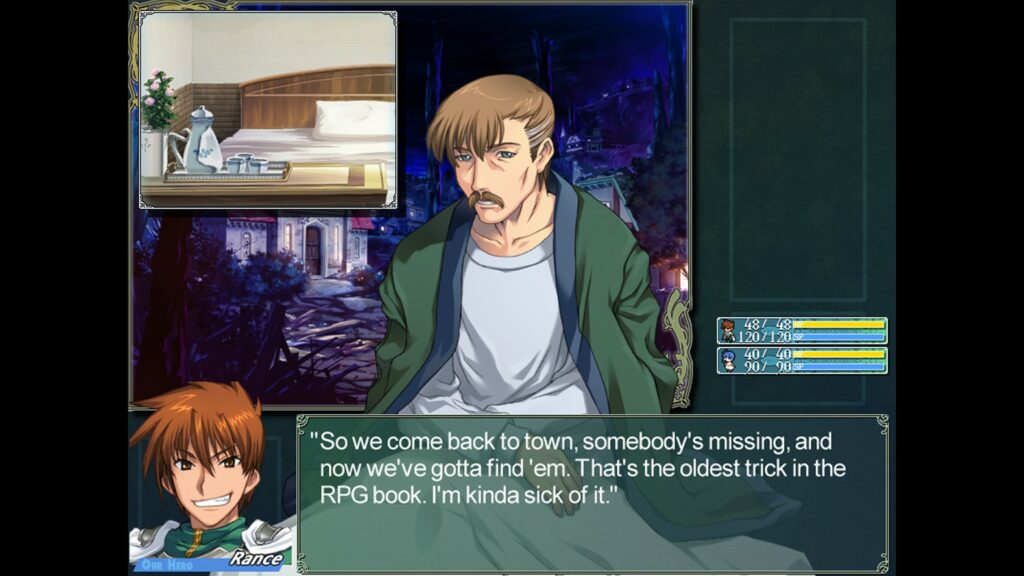
If that sounds scary, don’t be put off; while there’s an obvious resemblance between the two, Rance 02 isn’t anywhere near as complicated as Unlimited Saga. Instead, it simply shares a philosophy: the idea that you can make a game which eschews many of the usual trappings of “video games” in favour of something equally relatable yet distinct: tabletop gaming.
As we talked briefly about last time, Rance 02 features a few distinct components. In town, things are handled similarly to Rance 01 in that they resemble a Japanese-style adventure game: move between locations and choose between several different possible actions while you’re there.
Rance 02 doesn’t have a fixed “look, talk, touch, assault” interface as Rance 01 does, but in practice the available actions in each location tend to be the same: you can look around or at important people or things in the area; you can talk with people in the area or those who are accompanying Rance at the time; you can try and take something useful or use something in the area; or you can try your luck at either inflicting violence on someone or having sex with them.
Rance 02 adds an additional conversational option over and above Rance 01’s typical selections: “asking” about particular topics rather than simply generically “talking”. This is most commonly used in the game’s Info Shop, where you gather various pieces of information over the course of the game’s story and can use the Ask mechanic to remind yourself of the things you’ve previously discovered.
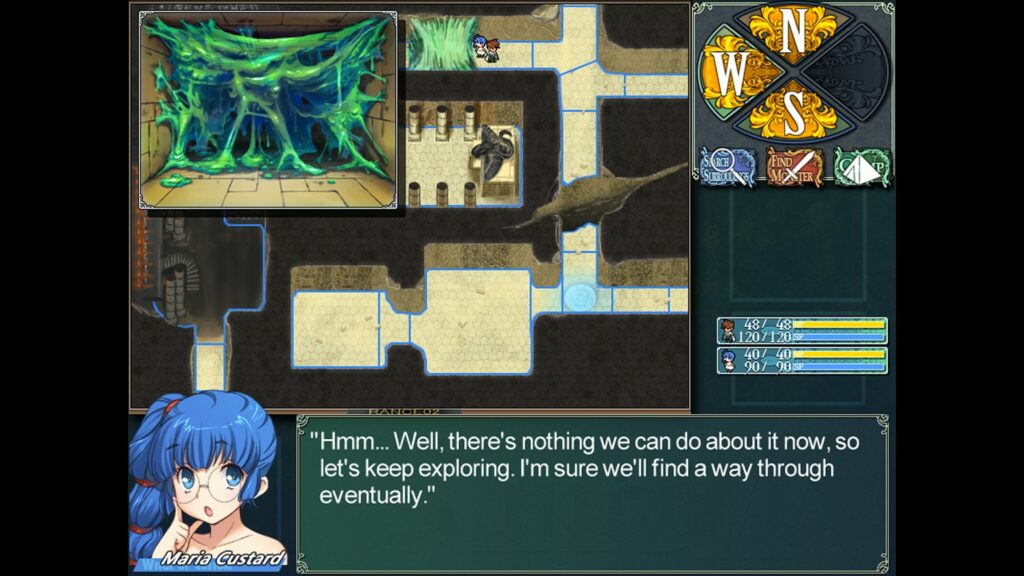
So far this is all very straightforward. But it’s when you get into the game’s dungeons — which is where you’ll spend the majority of the game — that things get interesting.
You’ll immediately see from the moment that you enter the dungeon that Rance 02’s dungeon-crawling is set up somewhat like a board game. Rather than moving freely around an environment, you instead move a playing piece representing your current party. This isn’t always led by Rance, either; as part of the narrative, Rance and his ever-present slave Sill become separated, leading to several chapters where they act independently of one another, with their own unique companions.
By clicking on a compass, you can move your playing piece one “space” in any available direction on the “board”. Upon reaching each space, you’ll get a short message summarising where you are, any notable features if they exist — and the game will also determine if you have a random encounter with a monster. If an encounter doesn’t occur, you can choose to deliberately trigger one for grinding purposes, or you can attempt to search the current space to see if anything interesting is hidden.
In the latter instance, if you find something important — which is usually clearly marked on the map, so there’s no need to blindly search seemingly empty spaces — then performing a search action will lead back to the adventure game-style interface, allowing you to interact with it more directly. In terms of the tabletop comparisons, this would be an analogue to a sequence in a board game like HeroQuest where the dungeon master player explains things verbally to the players rather than letting dice and cards doing the talking.
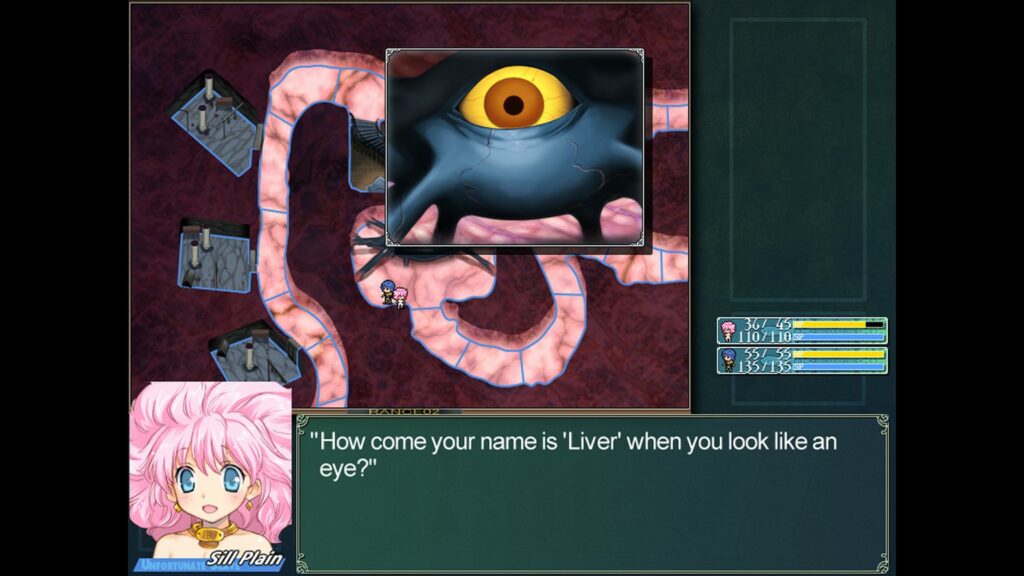
During the adventure sequences in Rance 02, you can’t usually do something irreversibly or fatally wrong — though there are a couple of exceptions here and there, so saving frequently is prudent. More often than not, the “wrong” choices for the actions to take are simply there for comedy value — such as a sequence where Rance sees a slot in a door big enough to fit a gem in, and has the option to put his dick in instead.
That said, some sequences can have notably different outcomes according to the choices you make. Early in the game, for example, you come across an injured adventurer in the dungeon, and you have the option to either allow Sill to cast healing magic on her and send her on her way, or for Rance to take advantage of the situation and rape her.
In the latter case — as with most similar incidents in other Rance games — the girl still ends up healed (physically if not mentally), and Rance’s treatment of her actually allows him to get some additional information out of her. Morally repugnant, of course, but perfectly in keeping with Rance’s personality and way of doing things; as uncomfortable as it might make some players feel, having this choice be the “right” one is absolutely in line with what we have already learned about Rance in our time with him so far. He was, after all, let’s not forget, specifically designed to be “a piece of shit”.
But more on that another time, because like Rance 01, there’s a surprising amount of depth and nuance to the treatment of sex in Rance 02, so we’ll return to that later.
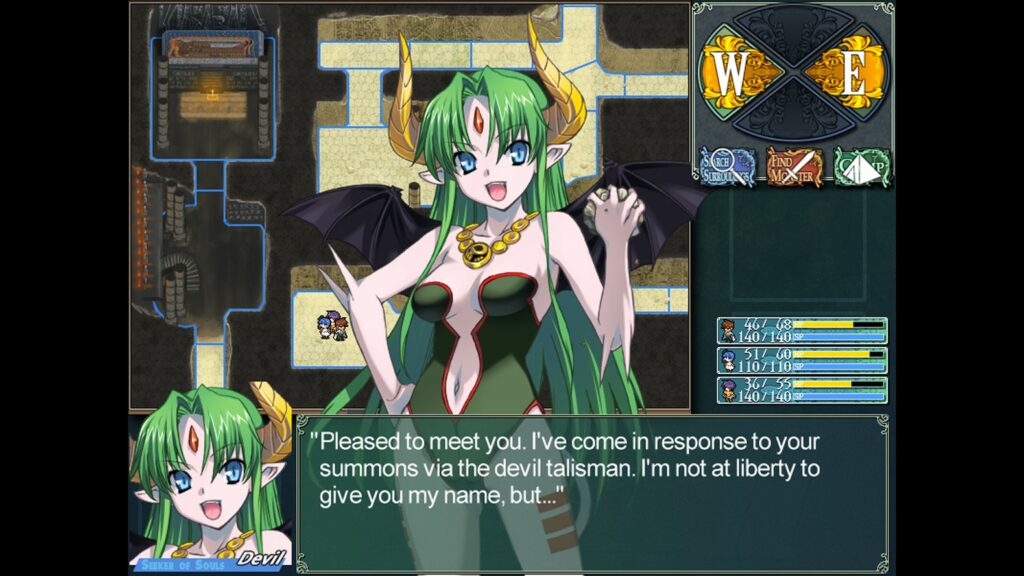
More often than not, successfully resolving the adventure sequences involves Rance (or Sill) and company being in possession of an appropriate item or piece of information; the game is pretty resolutely linear in that regard, much like most Japanese-style adventure games. There are relatively few cases in the game where there’s an element of chance in resolving a situation — though there is a treasure chest in the first dungeon that has an RPG-style “difficulty” rating which can’t be opened until Rance and Sill have levelled up a bit.
Rance 02’s combat, meanwhile, initially appears to be extremely simple. You only ever face a single monster at a time, you only control Rance’s actions, and the options you have available to you are quite limited.
Rance is able to make a normal attack with his weapon, unleash a more powerful “Rance Attack”, badmouth his enemies (which is usually completely ineffective, but there are a couple of specific cases in the game where it works), use an item, rest to recover stamina or run away from battle.
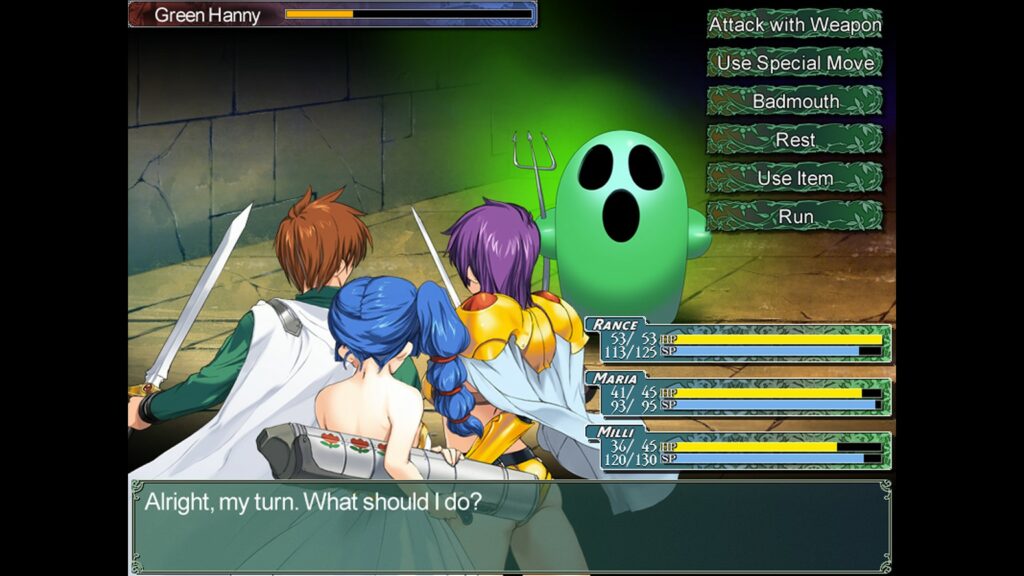
Attacking and using his special move both consume stamina, with the latter taking more, as you might expect. Interestingly, different weapons available in the game have different stamina costs, providing a simulation of how hard to handle or heavy they might be; the best sword you can buy strikes the best balance between stamina consumption and power.
Early in the game, stamina might not seem like a huge issue, as enemies go down quite easily and you can camp between every battle and rest to get everyone’s stamina back to full without penalty. But as you progress into the later chapters, the fights become significantly longer; the enemies don’t necessarily hit that much harder, but their larger pools of HP mean that stamina management becomes a much more major consideration while you’re fighting.
Rance’s party members, which vary over the course of the game, will act according to pretty simple rules: they’ll generally attack if they can, rest if they’re too low on stamina, and are quite likely to use a healing item if they’re below 50% HP; they’ll also heal Rance if his HP gets too low. The one tricky aspect is that you’re not able to tell them when to rest during combat, meaning if they end up exhausted there’s not a lot you can do about it.
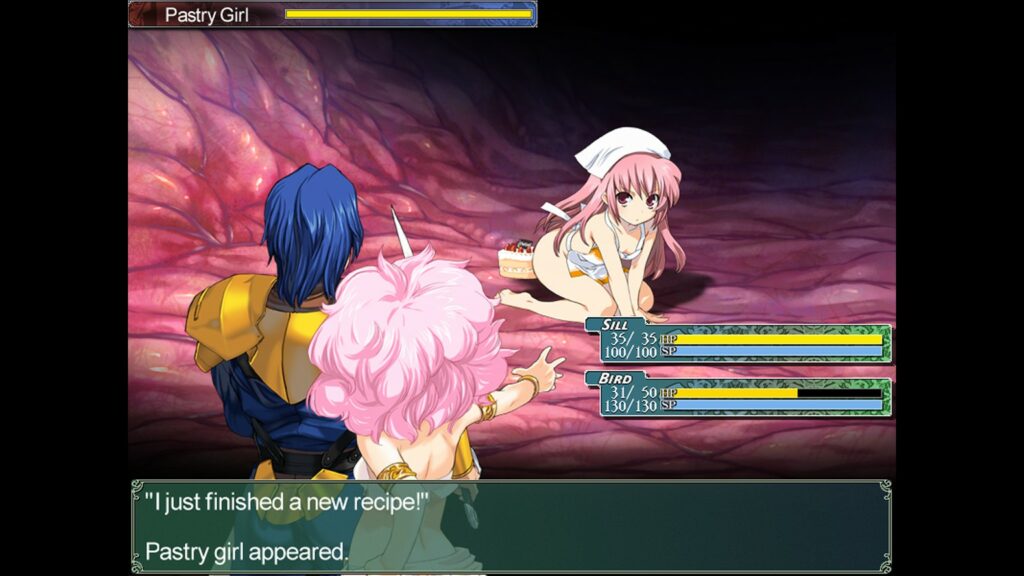
This doesn’t often become an issue, though towards the end of the game’s fourth chapter there’s a sequence where only one of the characters in Rance’s party is able to damage a series of enemies — and there’s no opportunity to rest between battles if you want to advance onwards. This is frustrating, but given the dialogue it’s clearly intended to feel like a struggle; as such, you’re best making use of Rance in a supportive capacity during this sequence, since he’s useless for anything else.
The chapters where Sill takes the lead are quite interesting, because Sill is absolutely terrible at physical combat, but as a mage, she is able to use both attack and healing magic. Casting spells has a high stamina cost, though, so it’s not something you can practically do every turn without some tactical resting; thankfully, her companion for her chapters is a strong physical attacker, meaning that Sill is placed very much in a supportive role. This makes them feel notably distinct from Rance’s chapters.
One of the nice things about the way Rance does things is that it feels like it cuts out a lot of the fluff. Being able to see the entire “game board” from the moment you step into a dungeon means that there’s minimal wandering around not knowing what to do next, and having clear options to interact with important objects in the dungeons means no faffing around trying to use everything on everything else in the hope something works.
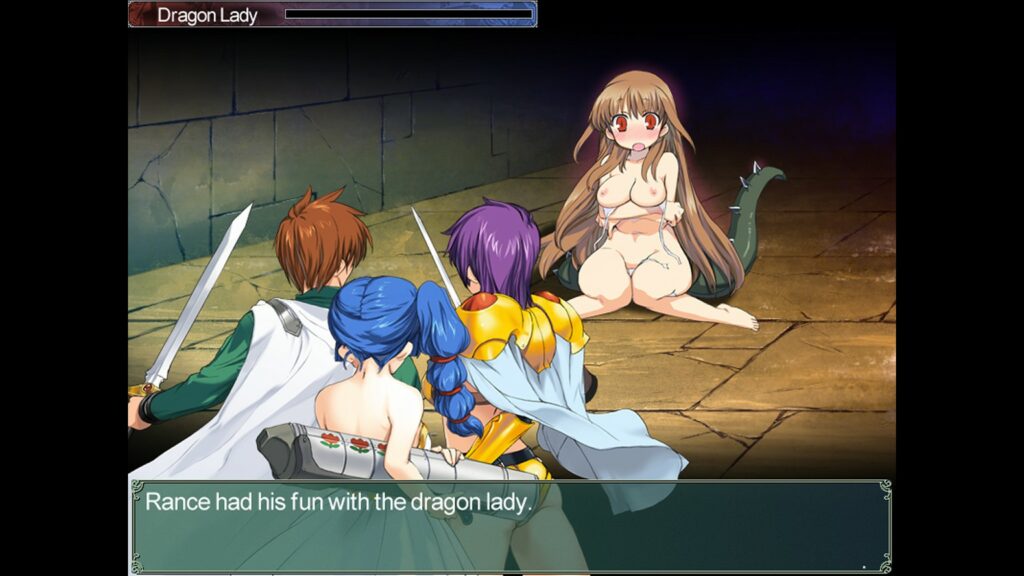
Rance 02 doesn’t demand grinding for success, but it doesn’t discourage it either — and indeed through the combination of the “Find Monster” button and the generous experience and gold drops from combat, it can actually be quite enjoyable to spend a bit of time buffing up the power levels of Rance, Sill and their companions.
Particularly as Willis the newly ascended level god gradually and inexplicably starts taking her clothes off (completely without comment or acknowledgement) as Rance’s levels get ever-higher — something which will be familiar to longstanding fans of the series, since she makes a bit of a habit of this. And yes you can fuck her once Rance reaches level 40 — though if you do so, she gets too mad to give you any more levels after that, so be sure you really want that level goddess cooch before diving in there. Or just, y’know, save your game.
My initial impressions of Rance 02 were that it probably wasn’t quite as solid a game as Rance 01 is, and I think that’s probably still true; after all, Rance 01 was completely rebuilt for a modern audience, while Rance 02 is mechanically almost identical to its original incarnation. But that doesn’t mean Rance 02 is a bad game by any means, either; on the contrary, it’s a title that becomes more rewarding and satisfying to play the longer you spend with it — and when you couple that with the excellent story and characterisation, you have the perfect recipe for a thoroughly compelling RPG that will keep you gripped right to the end.
So to speak.
Rance 02 is available in a double pack with Rance 01 from MangaGamer in both digital and physical format.
Join The Discussion
Rice Digital Discord
Rice Digital Twitter
Rice Digital Facebook
Or write us a letter for the Rice Digital Friday Letters Page by clicking here!
Disclosure: Some links in this article may be affiliate links, which means we may earn a small commission if you make a purchase after clicking on them. This is at no additional cost to you and helps support Rice Digital!
- Letter from the Editor: passing the torch - June 30, 2023
- Super Woden GP 2 is looking promising - June 30, 2023
- Inti Creates is making a 32 bit-style Love Live action platformer - June 26, 2023







